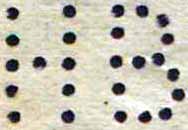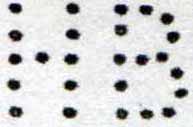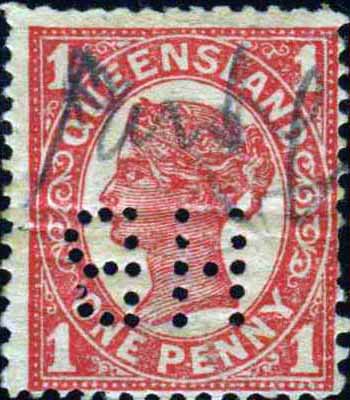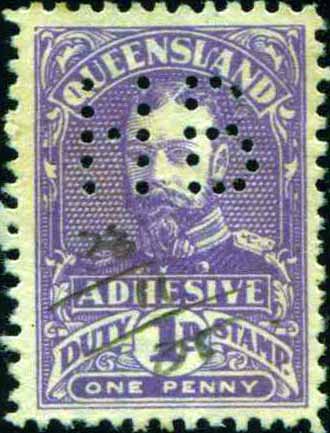|
Private Revenue Perfins of Queensland An Elsmore Coath production The authors would welcome your comments additions or input into this work
A B C E F G H I K L M N O P Q R S T V W Other H -------------------------------------------------------- HB.a User: Hardy Brothers Goldsmiths and Jeweller's Address: 116 Queen St, Brisbane, QLD Revenue Usage: QV State issue 1907-11 issue 1d. KGV 1917 issue 1d, 2d, 3d. Rarity Scale: QV State 1907-11 issue 1d (state) R4. KGV 1917 issue 1d R4, 2d R4, 3d R4. Background: John Hardy was born in Nottinghamshire, England, in 1831, the son of Samuel Hardy I, a jeweller and watchmaker, and his wife Catherine Esther, nee Wilson. His brother Samuel Hardy II was a retail jeweller at St. Ives, Huntingdonshire, England. On 31 July 1853 John arrived in Sydney aboard the ship 'Plantagenet' and was met by his cousin Felix Wilson. A few weeks later John established a jewellery business from his rooms at Jamieson Street, Sydney. Before leaving England, John had formed a partnership with his brother Samuel Hardy II, to trade in NSW selling jewellery from England. Samuel’s role was to source and ship the stock and John was to manage the retail sales in NSW. The partnership continued until Samuel II’s death in 1865. From 1861 John was joined in Sydney by his nephew Samuel Hardy III (born 1842) and he remained in Sydney until 1865 but returned to England following his father’s death. In 1869 Samuel III returned to Sydney to marry Emma Louisa Sparke. He then returned to England to conduct his fathers business but continued a partnership with his Uncle John. Between 1855 and 1934 Hardy Brothers operated from premises at 13 Hunter Street, Sydney but in 1934 they moved to Castlereagh Street, Sydney. In 1892 a branch of Hardy Brothers was opened in Brisbane at 116 Queens St with Walter Hardy, son of John Hardy, as manager. In 1917 (some sources 1918) a branch was opened in Melbourne at 298 Collins St. Hardy Brothers are known for their gold and silverware and have manufactured the Melbourne Cup. The company is the only holder of a Royal Warrant from Queen Elizabeth II, in Australia.
John Hardy (1831-1904) Today the company has 7 stores around Australia including two each in Sydney, Melbourne and Brisbane and a store in Perth. Device:
The HB Brisbane device was one of the 3 similar
devices used by Hardy Brothers in Brisbane, Sydney
and Melbourne. Only the Brisbane and Sydney
devices are found on revenue stamps. These 3
patterns are almost indistinguishable from each
other and are most accurately confirmed by postmarks
or there use on a given States revenue or postage
stamps. The
characteristics of the patterns are: Brisbane: Rounded
base of B Sydney: From
1913 missing pin second from base of spine of B Melbourne:
Centre pin of 3 of the base of the B is slightly
higher than the pins to either side giving a concave
look to the base. The
Brisbane HB device has not been reported on Railway
Stamps but is found used on Postage Stamps from 1913
to 1954. Related
Patterns: Refer to other Hardy Brothers patterns in: NSW: HB.a ------------------------------------------------------- HL.a User: Harringtons Limited Photographic, Theatre, Sound and Cinematograph, Merchants and Manufacturers Address: 212-214 Queen St, Brisbane, QLD Revenue Usage: Numeral 1d, 2d. Rarity Scale: Numeral 1d R4, 2d R4. Railway Usage: 1927 issue 1d, 3d. Rarity Scale: 1927 issue 1d R4, 3d R4. Background:
*Harringtons Limited was founded in Sydney in 1906
by brothers John and Thomas. They were metallurgists
initially involved in the Gold boom in Western
Australia but later become involved in the silver
residue technology used in the photographic
industry. This lead Harringtons into the
manufacturing and wholesaling of photographic
equipment. By 1930
they had offices across Australia and New Zealand
and dabbled in Cinema with the purchase of the
Raycophone System which they later sold to Kodak. Device: A
single head device which is found used on both
revenue and railways stamps as well as on postage
stamps between 1932 and 1945. The
device featured rather thick pins and these removed
a significant amount of the stamp. This and the
small size of revenue stamps meant that it is
generally found with strikes in positions 2, 4, 6
and 8. The scale of the die is much more suited to
the larger format railway stamps. Related
Patterns: Refer to other Harringtons patterns in: NSW: HLTD.a *Heritage Council of NSW. ------------------------------------------------------- HSCO.a User: Howard Smith Company Limited Shipping Agents Address: Brisbane Central Wharves. Boundary St, Brisbane, QLD Revenue Use: KEDVII 1908 issue 1d, 2d, 3d, 6d. Rarity Scale: KEDVII 1908 issue 1d R4, 2d R3, 3d R4, 6d R4. Background: *Captain William Howard
Smith arrived in Melbourne from Hull (Yorkshire) in
1854 and formed Howard Smith Limited and commenced
regular voyages between Melbourne and Geelong. In 1864 he extended this to a
Melbourne to Sydney passenger and cargo service and
later included Newcastle (1868), then Maryborough,
Adelaide, Brisbane and Rockhampton by 1880. This
network was further extended to include Western
Australia and Far North Queensland. Smith had established himself well
in coal importation and trading and this and the
growth in his passenger and general cargo services
lead to the accumulation of a large fleet. In the
late 1870s he had three of his sons in the
partnership and they took charge of the Melbourne,
Sydney and Brisbane offices. In 1883 the firm became
a limited liability company, William Howard Smith
and Sons Ltd. He was the managing director at
Melbourne before he retired from active management
in 1884 but he continued as chairman until 1887. Smith died in Melbourne in March
1890 aged 76, survived by his wife and seven sons
and two daughters. The business was reorganized
under the control of four sons, Edmund (Melbourne),
Walter (Geelong), Harold (Sydney), and Ormond
(Brisbane) In 1901 the company became Howard
Smith Company Ltd in 1901 and later in 1914 it
changed its name to Howard Smith Limited and it
expanded from its base in the coastal shipping trade
into the mining and sugar industries and later
engineering, hardware, towage and safety. The shipping activities continued
to grow until the late 1940’s when the company
ceased their involvement in the passenger trade. In
1969 Howard Smith withdrew from the shipping
business in and then in 2001 sold their towage
interests. The company and its remaining hardware
interests were absorbed by Wesfarmers Ltd., Perth,
the owners of the Bunnings chain. At this time
Howard Smith Ltd. was delisted from the Australian
Stock Exchange. Device Information: Most likely a
single head device this HSCO pattern is found on
revenue and postage stamps with usage all across the
Australia. The strikes found used in various
locations are essentially identical so it is
difficult to say if they were a series of identical
dies in separate devices or a device located
centrally (most likely the head office in Melbourne)
which perforated stamps for dispatch to user areas.
The central location would have faced the challenge
of obtaining revenue and postage stamps of the
various States and receiving these and returning
them to user areas. More likely that the
devices were a series of identical or related
devices located at least in the main State office in
each State. This argument for remote but
similar devices is supported by the fact that
company subsequently replaced the HSCO device(s)
with a range of devices of similar appearance in the
HSLD format and that these devices were allocated to
their various offices around Australia. Related Patterns: refer to other
Howard Smith patterns in: NSW: HSLD.a QLD: HSLD.a
HSLD.b HSLD.c SA: HSCO.a WA: HSCO.a * Australian Dictionary of Biography ------------------------------------------------------- HSLD.a User: Howard Smith Company Limited Shipping Agents Address: Brisbane Central Wharves. Boundary St, Brisbane, QLD Revenue Use: KGV 1920 issue 1d, 2d, 3d. Rarity Scale: KGV 1920 issue 1d R1, 2d R1, 3d R3. Background: See HSCO.a above Device:
This is a later device than the HSCO device used in
Brisbane and is one of a number of similar device
that are known to have been used in Brisbane,
Melbourne and Townsville. Only the Brisbane device
is known on revenue stamps. It is
most likely a single head device and it is first
found used on postage stamps in Melbourne but it
seem that it was relocated to Brisbane about 1916
where it is found used on both revenue and postage
stamps. There
is a device that is known to have been used in
Howard Smiths Townsville office that produces an
almost identical pattern but this is not known on
revenues. Related
Patterns: refer to other Howard Smith patterns in: NSW:
HSLD.a QLD:
HSCO.a HSLD.b HSLD.c SA:
HSCO.a VIC: HSCO.a WA: HSCO.a ------------------------------------------------------- HSLD.b User: Howard Smith Company Limited Shipping Agents Address: Innisfail, QLD Revenue Use: KEDVII 1908 issue 6d. KGV 1920 issue 1d, 2d. Numeral 1d, 2d, 3d. Rarity Scale: KEDVII 1908 issue 6d R4. KGV 1920 issue 1d R1, 2d R1. Numeral 1d R1, 2d R1, 3d R4. Background: See HSCO.a above Device:
Another of the very similar Howard Smith devices,
this one located in there offices in Innisfail where
the company had shipping interests as well as a
sugar cane mill at the nearby Mourilan. It
is found used on both postage and revenue stamps but
is more common on revenues. Related Patterns: refer to
other Howard Smith patterns in: NSW: HSLD.a QLD: HSCO.a
HSLD.a HSLD.c SA: HSCO.a VIC: HSCO.a WA: HSCO.a ------------------------------------------------------- HSLD.c User: Howard Smith Company Limited Shipping Agents Address: Cairns, QLD Revenue Use: KGV 1920 issue 1d, 2d. Rarity Scale: KGV 1920 issue 1d R4, 2d R4. Background: See HSCO.a above Device:
Another of the Howard Smith devices that produces a
similar pattern to many others. This is a
Cairns device and is found on postage stamps but
only rarely on revenues. The
pattern is characterised by a number of missing pins
in the H. I am yet to see a full strike of this
pattern. The
device is known that have been used from about 1917
through until 1940 and the missing pins are
consistent through this entire usage. Related
Patterns: refer to other Howard Smith patterns in: NSW:
HSLD.a QLD:
HSCO.a HSLD.a HSLD.b SA:
HSCO.a VIC:
HSCO.a WA: HSCO.a -------------------------------------------------------
A B C E F G H I K L M N O P Q R S T V W Other © copyright 2011 |














